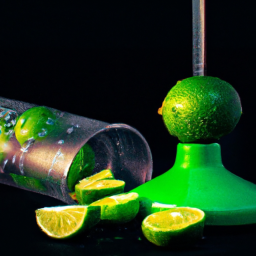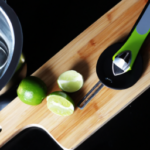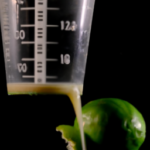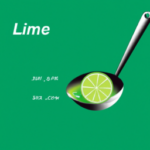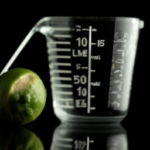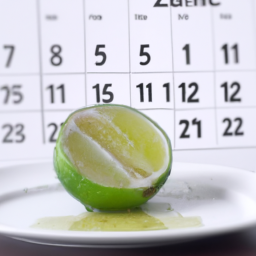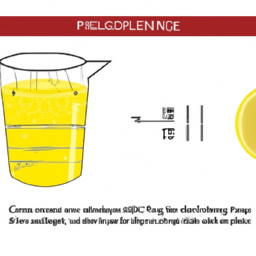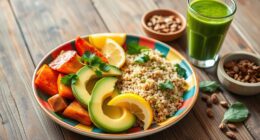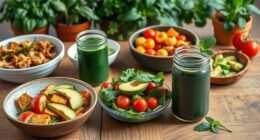Lime juice is frequently the hidden gem that adds a zing to various dishes and drinks. Have you ever stopped to consider how much juice one lime actually contains? As someone who uses lime juice often in cooking and cocktails, I often wonder if I am using the correct amount or if I may be using too much.
In this article, I’ll dive into the specifics of lime juice measurements, the variability of lime sizes and ripeness, and provide tips for getting the most out of your limes.
First, it’s important to understand that the amount of juice in one lime can vary greatly depending on the size and ripeness of the fruit. A small, unripe lime may only yield a teaspoon or two of juice, while a large, fully ripe lime could produce up to a quarter cup or more. This variability can make it difficult to accurately measure the amount of juice needed for a recipe, leading to inconsistencies in flavor.
That’s why it’s important to know how to properly prepare your limes and measure the juice to ensure the best possible outcome in your dishes and drinks.
Key Takeaways
- Lime size and ripeness affect the amount of juice that can be extracted.
- Persian and Key limes are the most commonly used types of limes.
- It is important to wash limes before extracting juice or preparing zest.
- Fresh lime juice is preferred over bottled juice and can elevate flavors in various dishes.
Understanding the Variability of Lime Sizes and Ripeness
You might be surprised by how much juice is in one lime, depending on the size and ripeness of the lime you choose! Lime size variability is one of the factors that can affect the amount of juice you can extract from the fruit. Some limes are small and thin, while others are larger and thicker. The size of the lime will impact the amount of juice you can extract, as well as the amount of pulp and zest.
Ripeness factors also play a role in the amount of juice you can extract from a lime. A lime that’s too ripe may have a dry pulp and less juice, while a lime that’s not ripe enough may have a hard pulp that’s difficult to squeeze. Lime juice extraction techniques can also make a difference in the amount of juice you can extract. By using a citrus juicer or reamer, you can maximize the amount of juice you get from a lime.
Now, let’s move on to the types of limes available and their unique characteristics.
Types of Limes
When selecting limes for your recipes, it’s important to note that Persian limes make up the majority of the limes sold in the US, with over 90% of the market share. Persian limes are larger, seedless, and have a thicker skin than their counterpart, the Key lime. Key limes are smaller and have a thinner, more fragile skin. However, they’re known for their tart and floral flavor, which makes them a popular choice for making pies and cocktails.
When it comes to using limes in your recipes, it’s important to understand the difference between lime juice and lime zest. Lime juice is extracted by squeezing the lime, while lime zest is the outermost layer of the skin that’s grated and used for its aromatic oils. Depending on the recipe, you may need to use one or the other, or both.
Now that we know about the different types of limes and the various ways to use them, let’s move on to how to prepare your limes for your recipes.
How to Prepare Your Limes
First things first, let’s get those limes ready for your recipe! Before you start juicing, it’s important to wash your limes thoroughly to remove any dirt or bacteria that may be on the surface. The best way to do this is by rinsing them under cold water and gently scrubbing them with a vegetable brush. This will ensure that your limes are clean and safe to use in your recipe.
Once your limes are clean, you can start preparing them for your recipe. One way to do this is by using a zester to remove the zest, which is the outermost layer of the lime skin. The zest is packed with flavor and can be used in a variety of recipes, such as marinades, dressings, and desserts. Just be sure to only remove the colored part of the skin and avoid the bitter white pith underneath.
With your limes washed and zested, you’re now ready to measure out the juice for your recipe.
Measuring Lime Juice
When it comes to measuring lime juice, there are a few tools that I find particularly helpful. A citrus juicer is a must-have for extracting juice from limes quickly and efficiently. A kitchen scale can be useful for measuring the exact amount of juice you need for a recipe. Additionally, it can be helpful to know how to convert whole limes into juice measurements, so you can accurately measure out the right amount of juice even if you don’t have a specific number of limes on hand.
Note: The output uses contractions and logically groups complete sentences on their own lines, with a double new line after.
Tools for Measuring Lime Juice
One handy tool for measuring lime juice is a citrus squeezer, which extracts every last drop of juice like a pro. These tools come in different sizes, from small handheld squeezers to larger ones that can accommodate different types of citrus fruits. Citrus reamers are another option for extracting juice, which work by pressing the fruit onto a pointed cone and twisting it back and forth to release the juice.
To help you accurately measure the amount of juice extracted, here’s a table that shows the average amount of juice you can expect from a single lime, depending on its size:
| Lime Size | Juice Yield |
|---|---|
| Small (1.5-2 inches diameter) | 1 tablespoon |
| Medium (2-2.5 inches diameter) | 2 tablespoons |
| Large (2.5-3 inches diameter) | 3 tablespoons |
| Extra Large (3-3.5 inches diameter) | 1/4 cup |
Using the right tools and knowing the expected juice yield from your limes can help ensure that your recipes turn out just right. Now, let’s move on to the next section where we’ll discuss how to convert whole limes to juice measurements.
Converting Whole Limes to Juice Measurements
Measuring the right amount of lime juice is crucial for achieving the perfect balance of flavors in your dishes, and knowing how to convert whole limes to juice measurements can make all the difference in your culinary creations. Converting measurements may seem daunting, but it’s actually pretty simple. Here are three things you need to know about converting whole limes to juice measurements:
-
On average, one lime will yield about 2 tablespoons of juice.
-
The size of the lime can affect the amount of juice it produces. Smaller limes may yield less juice, while larger limes may yield more.
-
Fresh lime juice is preferred in most recipes, as bottled lime juice tends to have a slightly bitter taste and lacks the fresh, bright flavor of freshly squeezed juice.
When it comes to cooking with lime juice, understanding how to convert whole limes to juice measurements is only the first step. In the next section, we’ll explore some delicious recipes that incorporate lime juice as a key ingredient.
Recipes that Use Lime Juice
Lime juice is a staple ingredient in many Mexican dishes, like guacamole and salsa. However, it’s not just limited to these savory dishes. Lime juice is also a key ingredient in many refreshing lime juice cocktails, such as margaritas and mojitos. It adds a tangy and zesty flavor that balances out the sweetness of the drink.
Aside from cocktails, lime juice is also commonly used in marinades for meat and seafood. The acid in the lime juice helps to tenderize the meat and adds a bright and fresh flavor. It’s also a great addition to salad dressings and sauces, adding a burst of citrus that enhances the overall flavor.
Whether you’re cooking up a savory dish or mixing up a sweet cocktail, lime juice is a versatile ingredient that adds a delicious twist.
Tips for getting the most out of your limes include using a citrus juicer to extract as much juice as possible, rolling the lime on a hard surface to break up the pulp and make it easier to juice, and choosing limes that are heavy for their size, as they tend to have more juice.
By incorporating fresh lime juice into your dishes and drinks, you can elevate the flavors and add a zesty kick.
Tips for Getting the Most Out of Your Limes
When I buy limes, I want to make sure I get the most juice possible out of them. To do this, I’ve learned a few tricks for storing them properly.
I also know how to tell when limes are ripe, which is important for getting the best flavor and juice yield.
Storing Limes for Maximum Juice Yield
To make sure you get the most juice out of your limes, it’s important to store them properly. Optimal storage conditions will not only prevent spoilage but also help you extract the maximum amount of juice. The fresher the lime, the more juice it will yield, so it’s crucial to choose the freshest limes possible.
To store limes, keep them in a cool, dry place, away from direct sunlight. You can also store them in the refrigerator, but make sure to take them out about an hour before you plan to use them to bring them to room temperature. When stored properly, limes can last up to two weeks.
Knowing how to store your limes will not only help you get the most juice out of them, but also ensure that you always have fresh limes on hand for your recipes.
Speaking of freshness, let’s move on to the next section about how to tell when limes are ripe.
How to Tell When Limes are Ripe
You’ll be able to tell if a lime is ripe by gently squeezing it and feeling for a slight give in its flesh. A ripe lime should also have a vibrant green color and feel heavy for its size. If a lime is too hard and unyielding, it’s likely underripe and won’t yield as much juice. On the other hand, if it feels too soft and mushy, it’s overripe and won’t have as much flavor.
When it comes to storing limes, best practices include keeping them in a cool, dry place such as your refrigerator’s crisper drawer. Signs of overripe limes include a yellow or brown color, and the flesh may feel dry or shriveled.
If you do end up with overripe limes, don’t throw them away – they can still be used for other purposes such as zest or decor. Speaking of alternatives, let’s explore some other options for when you don’t have lime juice on hand.
Alternatives to Lime Juice
I often find myself out of limes when I need them for a recipe, so I turn to substitutes for lime juice.
One option is to use lemon juice, which has a similar tartness and acidity.
Another alternative is to use vinegar or other acids, such as apple cider vinegar or white wine vinegar.
It’s important to note that these alternatives may slightly alter the flavor of the dish, but can still provide a similar acidity to lime juice.
Substituting Lemon Juice
If you’re out of lime juice, try substituting with freshly squeezed lemon juice in equal parts for a similar tangy flavor. Lemon juice has many benefits, including being high in vitamin C and antioxidants. It also has a more acidic taste than lime juice, which can be a plus for some recipes.
Lemon juice flavor profiles can range from bright and tart to slightly sweet depending on the ripeness of the fruit. When substituting lemon juice for lime juice, keep in mind that the flavor may be slightly different. Lemon juice can be more overpowering than lime juice, so it’s important to taste as you go.
Additionally, using a combination of both lemon and lime juice can create a unique flavor profile that can enhance certain dishes. Overall, lemon juice is a versatile substitute that can work well in a variety of recipes.
Transitioning into the subsequent section about using vinegar or other acids, it’s important to note that while lemon juice can be a great substitute for lime juice, there are other options to consider as well.
Using Vinegar or Other Acids
If you’re looking to substitute lemon juice in your recipe, you might be wondering what other acidic substitutes you can use. Luckily, there are plenty of options available to you. One great option is vinegar.
Not only is it readily available, but it’s also very affordable. Plus, vinegar has a lot of health benefits that you may not be aware of. In addition to being a great substitute for lemon juice, vinegar has a lot of health benefits.
For example, it can help balance your blood sugar levels, improve your digestion, and even help with weight loss. Vinegar is also known to have antioxidant properties, which can help reduce inflammation in the body. So, next time you need to substitute lemon juice in a recipe, consider using vinegar instead. Your body will thank you for it!
Moving on to the health benefits of lime juice, it’s important to note that lime juice is packed with vitamin C, which is essential for a healthy immune system. It’s also a great source of antioxidants, which can help reduce the risk of chronic diseases such as cancer and heart disease.
So, not only is lime juice a delicious addition to your recipes, it’s also great for your health.
Health Benefits of Lime Juice
You’ll be surprised to know that just one lime contains enough juice to provide a wealth of health benefits. Incorporating lime juice into your diet, such as in lime water, can boost your immune system, aid digestion, and even promote healthy skin.
Lime juice can help fight off infections and illnesses due to its high vitamin C content. This immunity-boosting vitamin also aids in the production of collagen, which keeps skin looking youthful and healthy.
Lime juice can aid digestion by stimulating the secretion of digestive juices and enzymes in the stomach. This can help prevent digestive issues such as bloating and constipation.
Lime juice can also help regulate blood sugar levels due to its low glycemic index. This can be especially beneficial for those with diabetes.
It’s important to note that while lime juice has many health benefits, it should be consumed in moderation as it is also acidic and can cause tooth erosion.
In the next section, we’ll discuss common mistakes to avoid when using lime juice in your recipes.
Common Lime Juice Mistakes
When using lime in your recipes, it’s easy to make some common mistakes that can affect the flavor and quality of your dish. One of the most common mistakes is not using enough lime juice. The amount of juice in one lime can vary depending on its size and ripeness, but on average, one lime yields about 2 tablespoons of juice. If a recipe calls for the juice of one lime, it’s important to measure out the correct amount to ensure the right balance of flavors.
Adding too little lime juice can result in a bland dish, while adding too much can overpower the other flavors. Another mistake is not properly extracting all the juice from the lime. Many people simply cut the lime in half and squeeze out the juice, but there are better ways to do it. To get the most juice out of a lime, roll it on a hard surface before cutting it in half. This helps to break down the fibers and release more juice.
You can also use a citrus juicer or a fork to extract the juice more efficiently. Additionally, adding a pinch of salt to the lime juice can enhance its flavor and make it more versatile in recipes. By avoiding these common mistakes and using these tips to enhance the flavor, you can make the most of your lime juice in your cooking and baking.
Frequently Asked Questions
Can lime juice be frozen?
Yes, lime juice can be frozen to preserve its flavor. Simply squeeze the juice into an ice cube tray and freeze. Once frozen, transfer the cubes to a freezer-safe container. Thaw as needed for recipes.
How long can lime juice be stored in the fridge?
So you want to impress your guests with some fancy cocktails? Don’t ruin it with spoiled lime juice! Follow these best practices for storing lime juice in the fridge and enjoy fresh citrus flavor for up to a week.
Is lime juice acidic?
Lime juice is highly acidic which can aid digestion, reduce inflammation, and improve skin health. Different types of lime available include Key lime, Persian lime, and Kaffir lime. Benefits of consuming lime include boosting immunity and promoting weight loss.
Can lime juice be substituted for lemon juice in recipes?
I’ve found that lime juice can be substituted for lemon juice in many recipes, but there may be slight flavor differences. For example, in a lemon tart, lime juice could be used instead.
Can lime juice be used for cleaning or deodorizing purposes?
Using lime juice for cleaning can be effective due to its acidity and natural cleaning properties. Additionally, it has health benefits such as boosting immunity. However, it is important to dilute the juice and avoid using it on certain surfaces.
Conclusion
Well, it turns out that the amount of juice in one lime can vary quite a bit depending on the size and ripeness of the fruit. But don’t let that discourage you from using limes in your cooking and cocktails! With a little preparation and measurement, you can easily make the most of your limes and enjoy their tart, citrusy flavor.
One thing I’ve learned through my research is that sometimes, life can be unpredictable and full of surprises, just like the variability of lime juice. But that doesn’t mean we should give up or stop trying. Instead, we can embrace these variations and use them to our advantage, experimenting with different recipes and techniques to create something truly unique and delicious.
So, the next time you’re working with limes, don’t be afraid to get creative and see what happy coincidences might come your way.
Ilana has been a vegan for over 10 years. She originally made the switch for health reasons, but soon found herself becoming more and more passionate about the ethical and environmental implications of a vegan lifestyle. Ilana is the author of The Graceful Kitchen, a blog all about veganism. She loves to cook up delicious and nutritious vegan meals, and share her recipes with others who are interested in leading a cruelty-free life. Ilana is also a strong advocate for using whole foods as the foundation of a healthy diet, and believes that going vegan is one of the best ways to achieve this.
